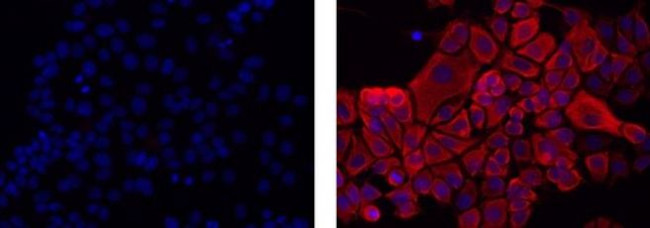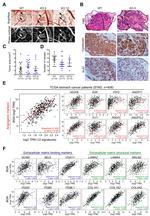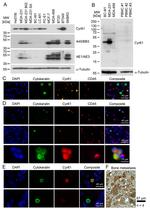Invitrogen
Pan Cytokeratin Monoclonal Antibody (AE1/AE3), eFluor™ 615, eBioscience™
Product Details
42-9003-82
Species Reactivity
Published species
Host/Isotype
Class
Type
Clone
Conjugate
Excitation/Emission Max
Form
Concentration
Purification
Storage buffer
Contains
Storage conditions
Shipping conditions
RRID
Product Specific Information
Description: The monoclonal antibodies AE1 and AE3 recognize many of the acidic and basic cytokeratin family members. Cytokeratins are intermediate filament proteins comprising one component of the cytoskeleton. There are two large families of cytokeratins, acidic and basic, but all contain the same basic domains (i.e. an alpha-helical core with an N- and C-terminal domain). The proteins are expressed in epithelial cells, but are developmentally regulated. Many tumors also express these proteins and their expression can help identify the origin of a neoplasm.
The AE3 monoclonal antibody recognizes the 65 to 67 triplet, 64, 59, 58, 56, 54 and 52kD proteins also known as cytokeratin 1, 2, 3, 4, 5, 6, 7, and 8 while the AE1 antibody recognizes 56.5, 54', 50, 50', 48, and 40 kDa proteins (also known as CK10, 14, 15, 16 and 19). These antibodies can be used on a wide array of tissue samples from mouse, human, rat, primates (cynomolgus and rhesus), dog, cat, rabbit, and chicken.
Applications Reported: This AE1/AE3 antibody has been reported for use in immunohistochemical staining, immunocytochemistry, immunohistochemical staining of frozen tissue sections, and immunohistochemical staining of formalin-fixed paraffin embedded tissue sections.
Applications Tested: This AE1/AE3 antibody has been tested by immunocytochemistry on methanol-fixed MCF7 cells and can be used at less than or equal to 5 µg/mL. It is recommended that the antibody be carefully titrated for optimal performance in the assay of interest. This product has not been validated for flow cytometric analysis.
Filter Recommendation: When using this eFluor® 615 antibody conjugate, we recommend a filter that will capture the 615 emission wavelength (for example, Excitation 560/55, 585LP, Emission 645/75). A standard Alexa Fluor® 594 filter is acceptable.
Excitation: 595 nm; Emission: 615 nm.
Filtration: 0.2 µm post-manufacturing filtered.
Target Information
Cytokeratin pan is part of a subfamily of intermediate filament proteins that are characterized by remarkable biochemical diversity, and represented in human epithelial tissues by at least 20 different polypeptides. Cytokeratins range in molecular weight between 40 kDa- 68 kDa, and an isoelectric pH between 4.9-7.8. The individual human cytokeratins are numbered 1 to 20. The various epithelia in the human body usually express cytokeratins which are not only characteristic of the type of epithelium, but also related to the degree of maturation or differentiation within an epithelium. Cytokeratin subtype expression patterns are used to an increasing extent in the distinction of different types of epithelial malignancies. The cytokeratin antibodies are not only of assistance in the differential diagnosis of tumors using immunohistochemistry on tissue sections, but are also a useful tool in cytopathology and flow cytometric assays. The composition of cytokeratin pairs vary with the epithelial cell type, stage of differentiation, cellular growth environment, and disease state. Many studies have shown the usefulness of keratins as markers in cancer research and tumor diagnosis.
For Research Use Only. Not for use in diagnostic procedures. Not for resale without express authorization.
Bioinformatics
Protein Aliases: 39.1; 40-kDa keratin intermediate filament; 47 kDa cytokeratin; 56 kDa cytokeratin; 57kd keratin; 57kDa keratin; 58 kDa cytokeratin; 60-kDa keratin; 65 kDa cytokeratin; 67 kDa cytokeratin; Cell proliferation-inducing gene 46 protein; CK-1; CK-10; CK-13; CK-14; CK-15; CK-16; CK-17; CK-18; CK-19; CK-1B; CK-2e; CK-2P; CK-3; CK-4; CK-5; CK-6A; CK-6D; CK-7; CK-8; cytokeratin 1; cytokeratin 10; cytokeratin 13; cytokeratin 14; cytokeratin 15; cytokeratin 16; cytokeratin 18; cytokeratin 19; cytokeratin 2; cytokeratin 3; cytokeratin 4; cytokeratin 5; cytokeratin 6A; cytokeratin 6C; cytokeratin 6D; Cytokeratin 7; cytokeratin 8; Cytokeratin endo A; Cytokeratin endo B; Cytokeratin-1; Cytokeratin-10; Cytokeratin-13; Cytokeratin-14; Cytokeratin-15; Cytokeratin-16; Cytokeratin-17; Cytokeratin-18; Cytokeratin-19; Cytokeratin-1B; Cytokeratin-2e; Cytokeratin-2P; Cytokeratin-3; Cytokeratin-4; Cytokeratin-5; Cytokeratin-6A; cytokeratin-6C; Cytokeratin-6D; cytokeratin-6E; Cytokeratin-7; Cytokeratin-8; Cytoskeletal 57 kDa keratin; embryonic type II keratin 1; Embryonic type II keratin-1; Endo B; epidermal keratin 10; epidermolysis bullosa simplex 2 Dowling-Meara/Kobner/Weber-Cockayne types; epidermolysis bullosa simplex, Dowling-Meara, Koebner; epidermolytic hyperkeratosis 1; epithelial keratin 1; epithelial keratin 10; epithelial keratin 2e; Epithelial keratin-1; Epithelial keratin-10; Epithelial keratin-2e; focal non-epidermolytic palmoplantar keratoderma; Hair alpha protein; HMWCK; intermediate filament protein; K1; K10; K13; K14; K15; K16; K17; K18; K19; K1B; K2e; K2P; K3; K3 keratin; K4; K5; K6A; K7; K76; K77; K8; kamp-keratin derived antimicrobial peptide; KDAMP; keratin 1 (epidermolytic hyperkeratosis); keratin 1, type II; keratin 10 (epidermolytic hyperkeratosis; keratosis palmaris et plantaris); keratin 10, type I; keratin 13; keratin 13, type I; keratin 14, type I; keratin 15, type I; keratin 16 (focal non-epidermolytic palmoplantar keratoderma); keratin 16, type I; keratin 17, type I; keratin 18, type I; keratin 19, type I; Keratin 1B; keratin 2 epidermis; keratin 2, type II; keratin 2A (epidermal ichthyosis bullosa of Siemens); keratin 2p; keratin 3, type II; keratin 4, type II; keratin 5 (epidermolysis bullosa simplex, Dowling-Meara/Kobner/Weber-Cockayne types); keratin 5, type II; keratin 6A, , type II; keratin 6A, type II; keratin 7, type II; keratin 76, type II; keratin 77; keratin 77, type II; keratin 8, type II; keratin 86; keratin complex 1, acidic, gene 10; keratin complex 1, acidic, gene 13; keratin complex 1, acidic, gene 14; keratin complex 1, acidic, gene 15; keratin complex 1, acidic, gene 16; keratin complex 1, acidic, gene 17; keratin complex 1, acidic, gene 18; keratin complex 1, acidic, gene 19; keratin complex 2, basic, gene 1; keratin complex 2, basic, gene 17; keratin complex 2, basic, gene 39; keratin complex 2, basic, gene 4; keratin complex 2, basic, gene 5; keratin complex 2, basic, gene 6a; keratin complex 2, basic, gene 6c; keratin complex 2, basic, gene 7; keratin complex 2, basic, gene 8; keratin complex 2, gene 17; keratin complex 2, gene 6a; Keratin D; keratin intermediate filament 16a; keratin intermediate filament 16b; keratin K3; keratin K6h; Keratin type II cytoskeletal 5; keratin, 55K type II cytoskeletal; keratin, epidermal type II, K6A; keratin, simple epithelial type I, K7; Keratin, type I cytoskeletal 10; Keratin, type I cytoskeletal 13; Keratin, type I cytoskeletal 14; Keratin, type I cytoskeletal 15; Keratin, type I cytoskeletal 16; Keratin, type I cytoskeletal 17; Keratin, type I cytoskeletal 18; Keratin, type I cytoskeletal 19; Keratin, type I cytoskeletal 59 kDa; keratin, type I, 40-kd; Keratin, type II cytoskeletal 1; Keratin, type II cytoskeletal 1b; Keratin, type II cytoskeletal 2 epidermal; Keratin, type II cytoskeletal 2 oral; Keratin, type II cytoskeletal 3; Keratin, type II cytoskeletal 4; Keratin, type II cytoskeletal 5; Keratin, type II cytoskeletal 6A; Keratin, type II cytoskeletal 7; Keratin, type II cytoskeletal 8; Keratin-1; Keratin-10; Keratin-13; Keratin-14; Keratin-15; keratin-15, basic; keratin-15, beta; Keratin-16; Keratin-17; Keratin-18; Keratin-19; Keratin-2 epidermis; Keratin-2e; Keratin-3; Keratin-4; Keratin-5; Keratin-6-alpha; Keratin-6A; keratin-6C; Keratin-7; Keratin-76; Keratin-77; Keratin-8; KRT1B; krt2; krt5; krt7; krt76; masticatory epithelia keratin 2p; mK6-alpha; pan Cytokeratin; pan keratin; pankeratin; Sarcolectin; suprabasal cytokeratin 10; tuftelin interacting protein 8; type I cytoskeletal 15; type II cytoskeletal 1b; type II keratin Kb39; type II mesothelial keratin K7; type-II intermediate filament protein; Type-II keratin Kb1; type-II keratin Kb12; Type-II keratin Kb2; Type-II keratin Kb3; Type-II Keratin Kb39; Type-II keratin Kb4; Type-II keratin Kb5; Type-II keratin Kb6; Type-II keratin Kb7; Type-II keratin Kb8; Type-II keratin Kb9
Gene Aliases: 2310001L23Rik; 2310016L08Rik; 3300001P10Rik; 39.1; 4732484G22Rik; AA960620; AI324768; AI528832; AI626930; AI663979; AL022697; AU019895; AW108092; AW146334; BB005427; BCIE; BIE; CARD2; CK-10; CK-17; CK-18; CK-2e; CK-3; CK-4; CK-6C; CK-6E; CK-8; CK1; CK10; CK13; CK14; CK15; CK16; CK18; CK19; CK3; CK4; CK5; CK6A; CK6C; CK6D; CK7; CK8; CYK18; CYK4; CYK8; D130054E02Rik; D15Wsu77e; DDD; DDD1; EBS2; EBS3; EBS4; EGK_03684; EGK_03685; EHK; EHK1; EndoA; EndoC; EPPK; FNEPPK; HUMCYT2A; K1; K10; K13; K14; K15; K16; K17; K18; K19; K1B; K1C1; K1CO; K1CP; K1CS; K1emb; K2C7; K2C8; K2E; K3; K4; K5; K6A; K6C; K6D; K7; K8; KER1; KER10; Ker2; Kerd; KO; KPP; Krt-1.10; Krt-1.13; Krt-1.14; Krt-1.19; Krt-2.1; Krt-2.4; Krt-2.8; KRT1; Krt1-10; Krt1-13; Krt1-14; Krt1-15; Krt1-16; Krt1-17; Krt1-18; Krt1-19; KRT10; KRT13; KRT14; KRT15; KRT16; KRT16A; KRT17; KRT18; KRT19; KRT1A; KRT1B; KRT2; Krt2-1; Krt2-17; Krt2-2; Krt2-4; Krt2-5; Krt2-6; Krt2-6a; Krt2-6c; Krt2-7; Krt2-8; Krt239; KRT2A; KRT2B; KRT2E; KRT2P; KRT3; KRT4; KRT5; KRT5A; Krt6; KRT6A; KRT6C; KRT6D; KRT7; KRT76; KRT77; KRT8; Krt86; KRTA; KRTB; KRTE; mK1b; mK6[a]; MK6a; NEPPK; NFJ; PC; PC1; PC2; PC3; PCHC1; PIG46; SCL; Tfip8; WSN1; WSN2
UniProt ID: (Dog) Q6EIY9, (Human) P04264, (Dog) Q6EIZ0, (Human) P13645, (Human) P13646, (Human) P02533, (Human) P19012, (Human) P08779, (Human) Q04695, (Human) P05783, (Human) P08727, (Human) P35908, (Human) P12035, (Rabbit) Q29426, (Human) P19013, (Human) P13647, (Human) P02538, (Human) P08729, (Human) Q01546, (Human) Q7Z794, (Human) P05787, (Mouse) P04104, (Mouse) P02535, (Mouse) P08730, (Mouse) Q61781, (Mouse) Q61414, (Mouse) Q9Z2K1, (Mouse) Q9QWL7, (Mouse) P05784, (Mouse) P19001, (Mouse) Q3TTY5, (Mouse) P07744, (Mouse) Q922U2, (Mouse) P50446, (Mouse) Q9DCV7, (Mouse) Q3UV17, (Mouse) Q6IFZ6, (Mouse) P11679
Entrez Gene ID: (Dog) 444857, (Rhesus monkey) 699320, (Rabbit) 100353415, (Human) 3848, (Rabbit) 100009029, (Dog) 491006, (Human) 3858, (Rhesus monkey) 702153, (Human) 3860, (Rhesus monkey) 706830, (Dog) 490983, (Rhesus monkey) 100426180, (Human) 3861, (Dog) 100685323, (Rabbit) 100341120, (Rhesus monkey) 106994041, (Dog) 100685404, (Human) 3866, (Dog) 490978, (Human) 3868, (Rhesus monkey) 707236, (Rabbit) 100341376, (Rhesus monkey) 100426330, (Human) 3872, (Dog) 490977, (Rabbit) 100344942, (Human) 3875, (Dog) 477601, (Rabbit) 100354174, (Human) 3880, (Dog) 100685481, (Rabbit) 100353162, (Rhesus monkey) 699567, (Human) 3849, (Dog) 444850, (Human) 3850, (Dog) 100683401, (Rabbit) 100353668, (Rhesus monkey) 100425096, (Human) 3851, (Dog) 100682832, (Rhesus monkey) 700060, (Rabbit) 100348388, (Human) 3852, (Rhesus monkey) 100424400, (Rabbit) 100352658, (Dog) 100687760, (Dog) 486523, (Human) 3853, (Dog) 477602, (Human) 3855, (Rabbit) 100345579, (Rhesus monkey) 697425, (Rhesus monkey) 699194, (Human) 51350, (Dog) 486518, (Human) 374454, (Rabbit) 103348273, (Dog) 100683333, (Rabbit) 100348891, (Human) 3856, (Dog) 486513, (Rhesus monkey) 700449, (Mouse) 16678, (Mouse) 16661, (Mouse) 16663, (Mouse) 16664, (Mouse) 16665, (Mouse) 16666, (Mouse) 16667, (Mouse) 16668, (Mouse) 16669, (Mouse) 16681, (Mouse) 16682, (Mouse) 110308, (Mouse) 16687, (Mouse) 110310, (Mouse) 77055, (Mouse) 406220, (Mouse) 16691, (Rabbit) 100344183, (Rhesus monkey) 718983

Performance Guarantee
If an Invitrogen™ antibody doesn't perform as described on our website or datasheet,we'll replace the product at no cost to you, or provide you with a credit for a future purchase.*
Learn more
We're here to help
Get expert recommendations for common problems or connect directly with an on staff expert for technical assistance related to applications, equipment and general product use.
Contact tech support












